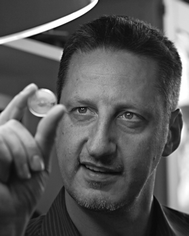DOI: 10.1039/C2LC90115C
(Profile)
Lab Chip, 2012, 12, 4603-4604
Contributors to the Scandinavian issue 2012
Henrik Bruus
Henrik Bruus received his Ph.D. degree in physics from Niels Bohr Institute, University of Copenhagen in 1990 and then worked as a postdoc at Nordic Institute of Theoretical Physics 1990–92, Yale University 1992–94 and CNRS Grenoble 1994–96. He returned to the Niels Bohr Institute as Associate Professor 1997–2001, before moving to the Technical University of Denmark in 2001. He became a full Professor of lab-chip systems in 2005 and of theoretical physics in 2012. He has (co)authored 110 journal papers on condensed matter physics and microfluidics, 140 conference papers and 2 monographs, the latest being “Theoretical Microfluidics”, Oxford University Press (2008).
Fredrik Höök
Fredrik Höök received a Ph.D. in physics from Chalmers, Sweden, in 1997 and his research has focused on the development of surface-based bioanalytical tools, such as QCM-D, localized SPR and more recently TIRF microscopy, and their combination with microfluidics for fundamental studies of cell-membrane mimics, but also for use in diagnostic and drug-screening applications. Efforts are presently focused on (i) new methods with single molecule sensitivity for studies of membrane proteins, (ii) microfluidic platforms for cell-membrane chromatography and (iii) sophisticated surface modifications and nanofabrication schemes to facilitate improved analysis of supported cell-membrane mimics, membrane proteins and virus binding and infection.
Aldo Jesorka
Aldo Jesorka received his diploma in chemistry from Universität Leipzig, Germany, in 1994. He conducted his Ph.D. research on biophotonic materials at the Max-Planck Institut für Strahlenchemie, Mülheim a. d. Ruhr and received his doctorate in natural sciences from Heinrich-Heine Universität Düsseldorf, Germany, in 2000. Since 2001 he has been working in the areas of integrative nanoscience, microfluidics and analytical chemistry at Chalmers University of Technology, Göteborg, Sweden.Jörg P. Kutter
Professor Jörg P. Kutter received his B.S in chemistry in 1991 and his Ph.D. in analytical chemistry in 1995, both from the University of Ulm, Germany. After graduation, he was a postdoctoral research fellow at Oak Ridge National Laboratory (Oak Ridge, TN, USA) developing microchip-based analytical tools. In June 1998, he joined the Department of Micro and Nanotechnology of the Technical University of Denmark (DTU) in Lyngby, Denmark. In 2006, he was appointed Professor in experimental lab-on-a-chip systems at DTU. He is the group leader of the ChemLabChip Group focusing on the development of microfluidic devices for applications in life sciences. Dr Kutter has extensive experience in leading scientific projects, has supervised and co-supervised 20 Ph.D. students, has more than 100 international peer-reviewed publications and books/book chapters and is involved in several international conference committees, advisory boards and professional organizations.
Thomas Laurell
Professor Thomas Laurell has held a position as Professor in Medical and Chemical Microsensors since 2000 and has a focus on lab-on-a-chip technologies in biomedicine. Laurell is an elected member of the Royal Swedish Academy of Sciences, as well as the Royal Swedish Academy of Engineering Sciences. He is currently the President of the Chemical and Biological Microsystems Society, CBMS, (http://www.cbmsociety.org). In 2008, Laurell started a new applied proteomics laboratory at the Biomedical Centre in Lund, integrating microfluidics and nanobiotechnology developments with disease biomarker proteomics and mass spectrometry. Since 2009 he has been director of the clinically oriented research environment CellCARE at Lund University, (http://www.cellcare.lth.se). The centre targets chip-based cell separation utilising acoustophoresis as the fundamental mode of separation, where diagnostics and therapeutics in prostate cancer, Parkinsons disease, leukemia and blood banking are primary areas of interest. Laurell also holds a position as Distinguished Professor at Dongguk University, Department of Biomedical Engineering, Seoul, Korea, since 2009.
Maria Nordin
Maria Nordin received her Master of Science in Engineering Nanoscience at Lund University in 2007. After working in the biotechnology industry for some time, she joined the department of Measurement Technology and Industrial Electrical Engineering in 2010, where she currently holds a position as a Ph.D. student. Her research interests are acoustic particle manipulation in microfluidic systems with a focus on biomedical applications.
Aman Russom
Aman Russom is an Assistant Professor in the Division of Nanobiotechnology at KTH Royal Institute of Technology, Stockholm, where he leads the Clinical Microfluidics Lab. He received his M.Sc. degree in Chemical Engineering in 2000 and his Ph.D. in 2005 from the Microsystem Technology lab at KTH. He then did his postdoc fellowship at Mehmet Toner's lab at Harvard Medical School from 2005–2008. His research focuses on BioMEMS with an emphasis on sample preparation for clinical diagnostics. He is involved with several EU projects and is currently coordinating one FP7 project.
Winnie Edith Svendsen
Associate Professor W. E. Svendsen completed her master degree with honors in 1993 from the University College Dublin. She received her doctorate in atomic physics in 1996 from Copenhagen University, Denmark. Thereafter, she held a postdoctoral position at the Max Planck Institute for Plasma physics, Garching, Germany. She returned to Denmark in 1998 and was appointed Associate Professor at Copenhagen University in 1999. Since 2001 she has been at the Danish Technical University. In 2006, she established her own research group Nano Bio Integrated Systems (NaBIS) applying micro and nanotechnology within biomedical applications. Winnie has more than 70 publications in international journals.
Zhigang Wu
Zhigang Wu received his Ph.D. degree in microfluidics from Nanyang Technological University (NTU), Singapore in 2005. Currently, he is an Associate Professor in Microsystems Technology, Uppsala University, Sweden and holds a research fellowship at the Swedish Research Council (SRC). His research interests are concentrated on polymeric lab-on-a-chip devices and systems for various applications in biology, life sciences, clinics, rehabilitation and home healthcare; and fundamental research and applications in microfluidic electronics and conformable intelligence for point-of-care healthcare and motion or fitness monitoring.
| This journal is © The Royal Society of Chemistry 2012 |








